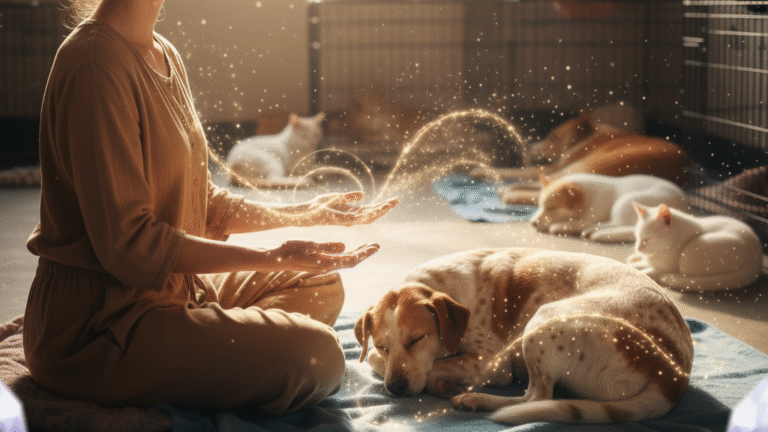Reiki For Rescue Animals: Restore Hope And Harmony
Rescue animals carry invisible scars from fear, neglect, or trauma. While shelter and care address physical needs, their emotional healing often goes overlooked. Reiki, a gentle energy healing practice, offers a powerful way to restore balance, calm, and trust.
Reiki for rescue animals provides a gentle, healing energy that helps them overcome trauma, reduce stress, and restore emotional balance.
This holistic approach nurtures both body and spirit, giving rescue animals hope, harmony, and a brighter path toward recovery and adoption.
Why Rescue Animals Need Reiki
Rescue animals often arrive at shelters carrying invisible wounds. Reiki, a gentle energy healing practice, helps fill this gap by calming the mind, reducing stress, and supporting holistic healing.
1. Emotional Healing
Reiki allows animals to release deep-seated fears and emotional pain. Through gentle energy work, they begin to feel safe, calm, and secure, gradually rebuilding trust in humans and forming positive connections that support long-term emotional recovery.
2. Stress Reduction
Shelters and foster homes can be overwhelming for rescue animals. Reiki calms the nervous system, lowers anxiety, and helps people cope with noise, new environments, or transitions, promoting relaxation and a sense of inner peace for better mental health.
3. Behavioural Improvement
Many rescued animals show fear-based aggression or withdrawal. Reiki helps regulate emotional responses, reduces anxiety-driven behaviours, and encourages calm, cooperative, and friendly interactions with humans and other animals, improving their overall behaviour and adaptability.
4. Enhanced Physical Recovery
Stress can slow healing from injuries or illness. Reiki supports the body’s natural repair mechanisms, improves energy flow, and strengthens resilience, allowing animals to recover faster while enhancing their overall vitality and immune system function.
5. Better Socialization
Animals that feel balanced and safe are more willing to engage positively with humans, other pets, and new environments. Reiki helps build confidence, making socialization smoother and more successful in shelters and adoptive homes.
6. Increased Adoption Chances
Calm, emotionally healthy animals are easier to integrate into new homes. Reiki improves temperament, reduces anxiety, and fosters trust, helping potential adopters feel confident and connecting rescued animals with loving forever families more quickly.

Step-by-Step Reiki Techniques For Rescue Animals
Discover simple, effective Reiki techniques designed to calm, heal, and support rescue animals, fostering trust, balance, and emotional well-being.
Step 1: Ground Yourself
Practicing grounding before a session enhances the effectiveness of Reiki for rescue animals, allowing them to receive calm, focused, and loving energy.
Find a quiet spot where you won’t be disturbed. Visualize roots connecting you to the earth. This centers your energy and clears stress.
A calm, grounded practitioner sends more focused, loving energy. Close your eyes if needed. Imagine tension melting from your body. Your peaceful energy flows naturally to the animal.
The tone for the entire session is established during grounding, which can take one to two minutes. Being centred makes the animal feel secure, at ease, and prepared to receive Reiki without interruption.
Step 2: Create A Safe Environment
Choose a quiet room or a familiar space where the animal feels secure. Remove loud noises, clutter, or distractions. Use blankets, favorite toys, or bedding to make them comfortable.
Dim the lights if indoors. A safe space encourages trust and relaxation. Outdoors, find a calm, enclosed area, like a backyard, with minimal foot traffic or sounds. Let the animal explore before beginning.
When they feel secure, Reiki energy flows more easily. Safety and comfort are essential for effective healing. Avoid forcing the animal to stay; let them move naturally while you prepare to offer energy support.
Step 3: Observe The Animal
Spend a few moments watching your animal before touching them. Look for body language cues: tail position, ear movements, or breathing patterns. Signs of tension, fear, or relaxation indicate energy needs.
Let the animal approach you on its own terms. Don’t rush. Observation builds understanding and trust. Notice subtle signs, like licking, yawning, or paw movement. These show receptiveness to energy work.
Some animals need more time; patience is vital. Recognizing their comfort level ensures a positive Reiki experience. Adjust your position, tone, and pace based on what you see. Respecting boundaries is essential for safety and trust.
Step 4: Scan The Energy
Hold your hands a few inches above the animal’s body. Move slowly, noticing areas that feel heavy, tense, or warm. These areas often need extra energy support. Avoid forcing your hands down; let the energy guide you.
Start at the head, moving toward the tail, then the legs. Observe reactions: slight shifts, nudges, or relaxation show areas receiving attention. Take your time; scanning is gentle, mindful, and calm.
Trust your intuition. Scanning reveals energy blockages and helps you direct healing where it’s most needed. This step ensures Reiki flows naturally, targeting both emotional and physical stress.

Step 5: Place Your Hands Gently
Using gentle hand placement and focused intention enhances the benefits of Reiki for rescue animals, promoting relaxation, comfort, and natural energy flow.
Use a soft touch and slow movements. Focus your mind on sending calm, loving energy. Avoid forcing positions; let the animal guide your placement. Common areas include the shoulders, back, chest, and head.
Keep your hands relaxed, fingers slightly curved. Visualize warmth and gentle energy flowing from your hands into their body. Speak softly if it helps them relax.
This direct connection allows energy to flow naturally. Animals may shift slightly—follow them. Comfort, patience, and mindfulness maximize the session’s effectiveness.
Step 6: Follow The Animal’s Cues
Animals communicate through subtle signals. They may nuzzle, move, or even leave your hands. Pay attention and follow their lead. Reiki is collaborative; the animal directs the energy flow.
Adjust your hands and position according to comfort and reactions. If they shift, let them guide you to the next area. Avoid forcing them to stay or lie down. Observe breathing, ear movement, and tail position to gauge comfort.
Respond calmly and gently. Following their cues builds trust, strengthens the connection, and ensures the healing is positive. Respecting boundaries is as important as the energy work itself.
Step 7: Focus On Intention
With your hands on or above the animal, concentrate on sending loving energy. Close your eyes or soften your gaze to focus internally.
Imagine stress, fear, and tension leaving their body. Visualize calm, healing light flowing through your hands into the areas that need it most.
Maintain a slow, steady rhythm. Your intention directs the energy, amplifying the healing effect. Avoid overthinking or expecting immediate results.
Stay patient and present. Positive intention is as vital as hand placement. Animals sense your focus and energy. This mindful intention helps them feel safe, balanced, and comforted.
Step 8: Keep Sessions Short
Start with brief sessions of 5–15 minutes, especially for anxious or new animals. Short, consistent sessions build trust gradually. Observe the animal’s responses; end if they show discomfort.
Over time, extend sessions as they become more comfortable. Daily or several-times-per-week sessions are more effective than one long session.
Short sessions prevent overwhelm and promote relaxation. Gradual exposure helps them associate Reiki with calm and safety. Even brief sessions can noticeably reduce stress and anxiety.
Monitor progress and adjust the length to suit the animal’s temperament. Consistency is more important than duration for long-term healing.
Step 9: Close The Session
Ending sessions with care and calm reinforces the healing effects of Reiki for rescue animals, helping them feel safe, peaceful, and supported. Avoid sudden movements. Offer water, a soft blanket, or gentle petting if they accept it.
Observe for any subtle changes in behaviour, breathing, or body tension. Thank the animal silently for allowing you to work with them. Give them time to process the session; don’t rush them back into activity.
Reflect on what you noticed during the session and take notes for future practice. Closing calmly reinforces trust and helps them retain the sense of safety and peace generated by Reiki.

Step 10: Practice Regularly
Consistency is key to long-term benefits. Aim for daily or several sessions per week. Regular Reiki reinforces calm, trust, and emotional healing.
Animals gradually become more confident, relaxed, and sociable. Record observations to track progress. Each session builds a stronger bond between you and the animal.
Over time, they will respond faster and more openly. Consistent practice enhances both emotional and physical recovery. Even short, mindful sessions have lasting effects.
By integrating Reiki into daily care routines, you support long-term balance, resilience, and well-being, giving rescue animals a better chance at happy, healthy lives.
Step 11: Allow Distance Reiki When Needed
Some rescue animals aren’t ready for touch. That’s okay. Sit a few feet away on the floor or ground. Make your body language soft—no direct staring, relaxed shoulders, slow breath. Rest your hands in your lap or lift them gently.
Set the intention to send love and calm. Picture a warm, gentle light flowing from your heart to theirs. Let energy bridge the space between you. This method feels safe and pressure-free.
Many animals slowly move closer once they sense trust and comfort. Distance Reiki gives them control—and control builds confidence.
Step 12: Offer Reiki During Calm Activities
Rescue animals often relax more during familiar routines. Try Reiki while they eat, play quietly, or rest in their favorite spot. Sit nearby, but not too close. Let them stay in their comfort zone.
Close your eyes or keep a soft gaze. Breathe deeply. Hold the intention of peace and safety. Keep your hands still and relaxed, allowing energy to flow naturally. When Reiki blends with everyday comfort, animals don’t feel “worked on.”
They simply feel supported. This approach helps them trust the energy and associate you with calm moments—not stress or pressure.
Step 13: Use A Gentle Voice Or Soft Sounds
Sound can be a powerful comfort. Speak in a soft, slow, reassuring tone. Whisper gentle phrases like “You’re safe” or “It’s okay.” You can also hum quietly or play calming nature sounds.
Sit somewhere peaceful—near their bed, crate, or favorite resting spot. Avoid sudden noises or fast talking. As you offer Reiki, let your voice become part of the soothing energy. This soft sound cue tells the animal they are safe.
Over time, they will connect your voice with comfort and healing. This strengthens emotional trust and brings more profound relaxation during future sessions.
Step 14: Visualize Protective Light Around Them
Visualization is a powerful tool in animal Reiki. Sit close but comfortable—maybe beside their bed or on the floor near their kennel.
Close your eyes. Imagine a soft bubble of white or golden light forming around the animal. Picture it like a warm blanket of safety.
See fear melting, and confidence rising. Let your breath stay slow and steady. You might place one hand near them or simply keep your hands relaxed on your lap.
This protective light creates emotional boundaries and eases trauma. Animals feel your intention. They sense safety—and healing becomes easier and deeper.

Step 15: Respect When The Session Is Over
Animals know what they need. When they turn away, stretch, sigh, or walk off, they’re saying “I’m done.” Respect it immediately. Don’t call them back.
Don’t try to continue. Just smile, soften your energy, and quietly thank them. End in a peaceful space—sitting near them or slowly stepping away. This teaches them that Reiki is never forced. It’s safe. It’s gentle.
It’s their choice. And that builds deep trust. Over time, they will stay longer, return for more, and even initiate sessions. Ending gracefully is its own healing act.
Step 16: Send Reiki To Their Past Trauma
Sending compassionate energy with focus and intention is the essence of Reiki for rescue animals, gently easing past trauma and fostering emotional healing.
To help gently heal the past, sit in a calm spot—maybe near their crate or favorite bed. Hold them in your heart, even if they aren't physically close. Don’t try to “fix.” Just send compassion.
Picture soft light flowing backward in time, easing fear and hurt. Imagine heavy memories dissolving and making space for comfort. You don’t need the story.
The intention alone brings support. Keep your breath slow and steady. End with gratitude and a quiet wish for their future to be filled with safety, joy, and love.
Step 17: Ground The Animal After The Session
After Reiki, rescue animals can feel dreamy, emotional, or tired—just like people do. Grounding helps them return to the present gently. Sit near them in a quiet space—indoors or outdoors.
If they’re comfortable with touch, softly stroke from head to tail along the spine. Move slowly, like you’re smoothing peace into their body. If they prefer space, simply sit close and breathe calmly.
Offer fresh water or a small treat afterward. Let them rest without interruption. This grounding moment closes the session and helps them feel safe and steady after emotional release.
Step 18: Integrate Reiki Into Daily Care
Reiki doesn’t always need a formal setup. Tiny moments bring significant healing. Try offering short bursts of loving energy during familiar routines—feeding time, brushing, or soft cuddles.
Sit at their level and breathe slowly. Place your hand lightly where they enjoy touch, or hover if they’re unsure. Even one minute counts. This makes Reiki a natural part of care, not a “special event.”
It builds trust gently. When healing blends with everyday life, rescue animals begin to associate love, safety, and connection with you—and with the world again.
Step 19: Journal Their Progress
Rescue animals heal in tiny, beautiful steps. Tracking those moments helps you see progress you might miss day-to-day. Keep a notebook or notes app handy.
After each session, jot down simple observations—body language, breathing, eye softness, willingness to stay near you.
Note how long the session lasted and how they reacted. Celebrate micro-wins: a relaxed sigh, a first tail wag, leaning closer instead of pulling away.
These little victories matter. Journaling also helps refine your approach and strengthen your bond. Every note becomes a reminder of how far they’ve come—and how powerful gentle healing can be.
Step 20: Practice Self-Reiki Too
Your energy sets the tone. Animals feel everything—stress, calm, joy, fear. To support them, keep your own heart centred. Practice self-Reiki daily, even for five minutes.
Practicing self-care enhances your ability to provide effective Reiki for rescue animals, ensuring your calm, balanced energy supports their healing and emotional safety.
Let your body soften. Release tension and return to peace. When you’re grounded, rescue animals sense safety and open up more easily.
Self-Reiki isn’t selfish—it’s part of caring for them. Healing flows through you, so nurture your own balance first. A calm soul becomes a safe harbour for themselves.

FAQs
Q1: Can Reiki Help Rescue Animals?
Yes. Reiki soothes trauma, restores emotional balance, and helps rescue animals rebuild trust. It eases fear and promotes a sense of safety, stability, and love during recovery.
Q2: Is Physical Touch Necessary?
No. Reiki energy transcends distance, so physical contact isn’t required. Practitioners can send healing energy remotely, making it ideal for anxious, injured, or touch-sensitive animals needing gentle care.
Q3: How Long Is A Session?
Reiki sessions for animals usually last 5–15 minutes. Short, focused sessions keep them relaxed and engaged while avoiding overstimulation, ensuring healing occurs naturally and comfortably at their own pace.
Q4: Can Reiki Replace Vets?
No. Reiki complements veterinary care but never replaces it. It supports healing by reducing stress and enhancing well-being while allowing traditional treatments to work more effectively together.
Q5: Signs Of Benefit?
After Reiki, animals may show relaxed postures, soft eyes, yawns, or sighs. They appear calmer, more trusting, and peaceful, signalling emotional release and restored energetic balance.
Q6: How Often Should Sessions Be?
Daily or multiple weekly sessions offer the best results. Regular Reiki builds familiarity, maintains balance, and helps animals steadily release emotional or physical blockages over time.
Q7: Can Anyone Do Reiki?
Yes. Anyone can learn Reiki with proper guidance, attunement, and compassion. Training ensures energy flows safely and effectively to promote healing and comfort in animals.
Q8: Do All Animals Respond?
Responses differ. Some feel Reiki immediately, while others take time to trust the process. Consistent practice and patience help animals open up and receive energy fully.
Q9: Is It Safe For Fearful Animals?
Yes. Reiki is non-invasive and respects each animal’s boundaries. Practitioners allow the animal to lead, ensuring comfort, safety, and gradual acceptance of healing energy.
Q10: Does It Improve Adoption Chances?
Yes. Reiki calms rescued animals, builds confidence, and reduces anxiety. Peaceful, emotionally balanced pets connect better with humans, greatly increasing their chances of successful adoption.
Conclusion
Reiki offers rescue animals a gentle bridge from fear to trust, and from trauma to peace. Consistent practice of Reiki for rescue animals helps them release fear, build trust, and experience emotional healing and lasting peace.
Every quiet session builds confidence and connection, reminding them they are seen, loved, and worthy of comfort. As we support their healing, we don’t just calm their bodies—we restore hope in their hearts and help them step into the joyful life they truly deserve.
I trust you enjoyed this article on Reiki For Rescue Animals – Restore Hope And Harmony In Every Heart. Please stay tuned for more Reiki insights, pet wellness tips, and holistic lifestyle ideas.
Take care!
— JeannetteZ
💬 Your Opinion Is Important To Me
Do you have thoughts, ideas, or questions? I’d love to hear from you. Please leave your comments below or email me directly at Jeannette@pawreiki.com.
🐾 More PawReiki Reads
💜 My #1 Recommendation for Online Success
Reiki has been life-changing for me, and I love sharing it online. If you’ve ever wondered how Reiki lovers turn their passion into a thriving business, this platform is the best place to start.
🌟 See How Reiki Lovers Build Online Income — Try WA Free (No Credit Card Needed)
Disclosure
This post may contain affiliate links. I earn from qualifying purchases at no extra cost to you. Please read my full disclosure.







